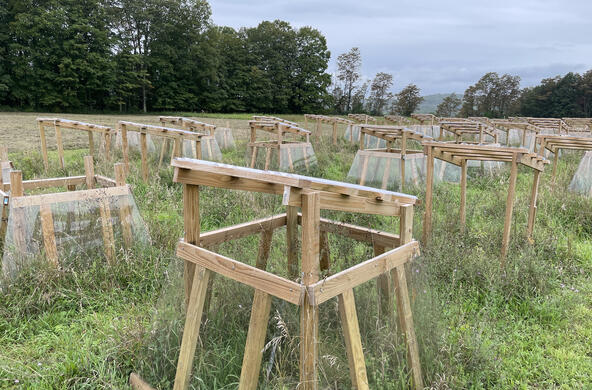Glyphosate is the most widely used herbicide in the United States with applications ranging between 250 and 300 million pounds per year during the past 10 years, largely on corn and soybean in the Midwest.
The producers of glyphosate strongly defend it as safe and effective, whereas a wide variety of environmental advocacy groups strongly oppose its use and its fugitive escape to nature. Their argument is bolstered by recent evidence that glyphosate causes Non-Hodgkin Lymphoma in rodents. To date, the U.S. Environmental Protection Agency has maintained that glyphosate is safe and set a water quality standard of 700 parts per billion (ppb =700 μg/L) for glyphosate in drinking water.
Glyphosate was first isolated by scientists at Monsanto Corporation and patented as a herbicide in 1974. It is sold commercially as Round-up®. Its use skyrocketed after the mid-1990s, when genetically modified crop plants were developed that were resistant to glyphosate, allowing it to be applied to fields to eradicate nuisance weeds without harm to the crop. These are known as Round-up Ready® varieties. The use of glyphosate was also bolstered by the widespread implementation of no-till agriculture, which, in the absence of cultivation, requires weed control via herbicides.
Glyphosate inhibits plant biochemistry in the shikimatic acid pathway that is essential to protein synthesis. Without this pathway, plants cannot grow. The absence of this pathway in animals led to the belief that glyphosate would have no direct effects on animals that were inadvertently exposed to its use. However, potential indirect effects on other aspects of animal biochemistry and genetics were largely ignored.
Glyphosate is soluble in water, so it is potentially subject to leaching to groundwater and surface waters draining agricultural land. It is, however, strongly adsorbed to clay and iron/aluminum oxide minerals that dramatically reduce the movement of glyphosate in nature. One study found that only 0.24% of applied glyphosate was leached from soils. When runoff waters carry suspended sediments, most glyphosate will be carried on the particles. Adsorbed glyphosate in soil is subject to microbial degradation, and the half-life of glyphosate in soils is measured at ≤ 200 days, usually much lower. We know little about whether soil-adsorbed glyphosate can be harmful to non-target organisms, including humans, at low concentrations.
Reported concentrations of glyphosate in drainage ditches, streams, rivers, and lakes in the U.S, where median concentrations range from 0.02 to 0.34 ppb. Medalie et al. found glyphosate detectable at low levels (median 0.09 ppb) in up to 74% of stream samples collected across the U.S. in 2015 to 2017. Glyphosate is not volatile but is entrained in atmospheric aerosols from the drift of spray and wind erosion and is found in rainfall samples downwind of its use. A compilation of 85 studies largely in the Midwest reported a median concentration of 0.11 ppb in precipitation.
Humans have inadvertent exposure to glyphosate through their food and cotton products. A survey in Iowa found little difference between farm and non-farm workers in the glyphosate content of their urine, implying that regional environmental exposure, rather than acute occupational exposure, predominated. One study reported glyphosate averaging 0.39 ppb in 81% of the urine samples collected from more than 2000 individuals across the U.S. In France the incidence was 99%.
The question of glyphosate safety revolves around the efficacy of the EPA standard (700 ppb) as a threshold for direct and epigenetic effects. Most laboratory studies have used concentrations greater than 5000 ppb to test for the effects of glyphosate on animals, frequently reporting toxicity only at levels exceeding 10,000 ppb. Amphibians are especially vulnerable. There is an implicit assumption that statistically significant effects of glyphosate at high concentrations extend to exposure at lower concentrations, but there are few studies of the effects of long-term, low-level exposure to glyphosate. There is a critical need for studies of the toxic effects of glyphosate at concentrations of 0.1 to 100 ppb in water.
Epidemiological studies have linked glyphosate to a wide variety of maladies, including breast cancer, decreasing testosterone, kidney disease, non-Hodgkin lymphoma, and nervous system disorders. Most of these studies are correlational and involve simultaneous exposure to multiple pesticides and their carriers. Studies of carcinogenicity of glyphosate in rodents typically use exposures in excess of 1,000,000 ppb in drinking water. Clearly, there is a critical need to develop dose-response relationships to allow statistically valid extrapolations from laboratory studies using acute exposures at high concentrations of glyphosate to long-term low-level concentrations are reported in the field.
Repeated applications of glyphosate may inhibit the soil microbes responsible for its degradation. Regular use of glyphosate has been associated with yield reduction in some crops, inasmuch as it reduces the resistance of crop plants to certain diseases. There is also some evidence for evolved genetic resistance of weeds to glyphosate. While not frequent, such observations are likely to reduce the use of glyphosate, as farmers are traditionally very sensitive to loss of yield. Already, the annual use of glyphosate has leveled off, even declined slightly, likely due to adverse publicity surrounding its potential health effects.
We are all destined for life-long exposure to low levels of glyphosate, and the European Commission seems poised to approve glyphosate for another ten years. When the potential profits are huge and the product efficacy is favorable, environmental science has difficulty demonstrating long-term effects at low dosage.
Selected References
(contact WHS if further background is desired)
Maggi, F., F.H.M. Tang, and F.N. Tubiello. 2023. Agricultural pesticide land budget and river discharge to oceans. Nature 620: 1013-1017.
Medalie, L. and six others. 2020. Influence of land use and region on glyphosate and aminomethylphosponic acid to streams in the USA. Science of the Total Environment 707: doi: 10.1016/j.scitotenv.2019.136008
Meflaul, I.M. and six others. 2020. Controversies over human health and ecological impacts of glyphosate: Is it to be banned in modern agriculture? Environmental Pollution 263: doi: 10.1016/j.envpol.2020.114372
Relyea, R. 21005. The lethal impact of roundup on aquatic and terrestrial amphibians. Ecological Applications 15: 1118-1124.







